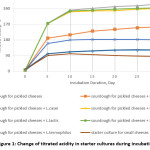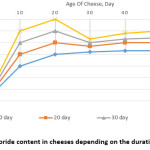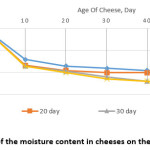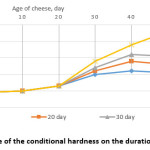Introduction
Currently, the number of studies on the development of new types of soft and (included in this group according to the new classification) brine cheeses has increased due to the presence of a number of advantages over hard cheeses. The production of soft cheeses is more economical, since their production consumes 1.5 times less milk, there are no high specific requirements for its quality, significant production areas are not needed for long-term maturation, storage of cheeses and installation of expensive specialized cheese-making equipment1,2,3,4. The organization of their production provides a faster turnover of invested funds and allows to smooth out the seasonality of cheese manufacture5,6,7. Cheeses of this group have good marketable properties and increased biological value. The production of soft and fresh cheeses can be organized at any dairy plant8,9,10. At the same time, the disadvantages of the technology of the main representative of the cheeses of this group – Adygea, show that long (over 30 min) molding processes and (6-16 h) self-pressing reduce moisture and fat content in the dry matter of cheese. This often leads to a product with a rough, crumbly consistency that is non-standard in physico-chemical parameters.
The technology of most brine cheeses also has significant disadvantages: prolonged self-pressing, maturation and storage in brine, transportation and sale in barrels with brine, etc. This is the reason for the appearance of such defects as an excessively salty, sour taste, rough and crumbly consistency, and the licking of the cheese surface11,12,13.
It seems expedient and justified to use additional raw materials – goat’s milk – to produce cheeses of this group. Of particular interest are the hypoallergenic and biological properties of goat’s milk14,15,16. Medicine assigns a special role to goat’s milk as a food product for weakened and food-allergic children. Allergy sufferers are usually sensitive to cow’s milk protein (asl-casein), and goat’s milk contains half as much of this fraction17,.18.
The aim of the study was to study the effect of technological processing on the quality of goat’s milk cheeses.
Materials and Methods
The objects of research were: goat’s milk, goat’s milk cheeses.
Laboratory studies of prototypes were carried out in the laboratory of the Department of “Food Technology” of the Almaty Technological University (Almaty, Republic of Kazakhstan).
Standard tests were used to determine the physico-chemical composition of milk. A descriptive method based on the determination of organoleptic parameters was used to characterize milk. Also, along with this, generally accepted methods for determining physical, chemical and biochemical parameters were used. Research methods used in the work: to determine the titrated acidity – titrimetric method (GOST 3624-92), to determine the mass fraction of protein – the method of titration with formol (GOST 25179-2014); the mass fraction of dry matter was determined by drying to a constant mass (GOST 3626-73), milk lactose was determined by the refractometric method (GOST R 51259-99); titrated acidity in the control and test object was determined according to GOST 3624-92; organoleptic parameters in the control and test object were determined according to GOST R ISO 22935-1-2011; density was checked by hydrometric method using an AMT type hydrometer (Eximlab, Russia) with a density scale and a thermometer for determining the temperature of milk (GOST 54758-2011); the fat content of the product was determined according to GOST 5867-90.18,19,20,21,22,23.
Titrated acidity is determined according to GOST 3624-92. The method is based on titration of milk with an alkali solution (sodium or potassium hydroxide) in the presence of a phenolphthalein indicator.
The surface layer is up to 10 mm thick, in the case of a skinless layer – up to 2 mm. Brine cheese, if necessary, is placed on a mesh stand or filter paper, covered with a lid and kept, depending on the type of cheese, for 2-4 hours at a temperature of (20 ± 5) ° C. The sample is rubbed through a grater, placed in a porcelain mortar and thoroughly mixed. From 1.8 to 2.2 g of cheese, cheese or salted cottage cheese products are weighed on a watch glass or in a bux with an error of no more than 0.001 g and transferred to a conical flask. A 25 cm3 solution of silver nitrate is added to the flask with a pipette, then 25 cm3 of nitric acid is poured with a graduated cylinder and thoroughly mixed. The mixture is heated in a fume hood to a boil, 10 cm3 of potassium permanganate solution is added and the reacting mixture is kept in a low-boiling state. If the reacting mixture changes color from dark brown to light yellow or colorless, then a solution of potassium permanganate in a volume of 5 to 10 cm3 is added. The presence of an excessive amount of potassium permanganate (the brown color of the mixture) shows that a complete decomposition of organic matter has occurred. The excess amount of potassium permanganate is removed by adding oxalic acid or glucose until the brown color disappears. Then 100 cm3 of distilled water and 2 cm3 of a solution of iron-ammonium alum are poured into the flask with the mixture and thoroughly mixed. The excess amount of silver nitrate is titrated with a solution of potassium rhodanide or ammonium until a red-brown color appears, which does not disappear within 30 seconds. In parallel, a control experiment is carried out using 2 cm of distilled water instead of 2 g of cheese, cheese or salted cottage cheese products. For the final result of the analysis, the arithmetic mean of the results of two parallel definitions is taken, the permissible discrepancies between which should not exceed 0.07%.
Results
Investigation of the effect of technological processing on the quality of dairy raw materials for cheese production
According to physical and chemical parameters, goat’s milk must meet the requirements given in Table 1.
Table 1: Physical and chemical parameters of goat milk.
| The name of the indicator | The norm for milk | ||
| The highest grade | First class | Unsorted | |
| Acidity | From 15.00 to 18.00 | From 16.00 д to 19.99 | Less than 14.99 or more than 20.00 |
| Purity group, not lower | I | II | III |
| Density, kg/m3, not less | 1028.0 | 1027.0 | Less than 1026.9 |
| Freezing point, °С | Less than 14.99 or more than 20.00 Not higher than minus 0.520 | Above minus 0.520 | |
Milk at the dispenser is stored at a temperature of (4±2)°С with no more than 24 hours. When handing over to dairy industry enterprises, the temperature of milk should not be higher than 8 °C.
Thermization contributes to the destruction of most psychrotrophic microorganisms even before the latter would multiply and produce undesirable enzymes that remain resistant and cause spoilage of the finished product.
Based on the work carried out, the preparation of milk with the first heat treatment at 65 °C for 20-25 seconds was recognized as optimal in microbiological (total number of bacteria, proteolytic, lactic acid, psychrophilic bacteria and Escherichia coli) and technological indicators (acidity and rennet coagulability). and its subsequent pasteurization according to the generally accepted regime (72°C for 20-25 seconds). Such treatment does not adversely affect the basic physico-chemical and technological properties of milk, while its sanitary and hygienic indicators will improve. The above method of processing milk allows you to extend its shelf life at 8 °C to 48-72 hours, while raw milk after this period of time becomes unsuitable for cheese production.
Discussion
The results of studies on the thermization of goat’s milk show a certain practical interest. Despite the pasteurization of milk used in this method at 72 °C, it was possible to practically preserve most of its original properties. At the same time, this milk contained fewer bacteria compared to other variants.
Taking into account the conducted research and practical experience, it is advisable to carry out the maturation of thermized goat’s milk at 65°C, followed by its pasteurization at 72-75 °C.
Table 2: Summary data on changes in the microbiological composition and technological properties of ripened thermized milk.
| Indicators | Raw fresh milk | After processing |
| Total number of bacteria; CFU/ml | 1.3 * 106 | 2.9 * 104 |
| Titrated acidity, °Т | 17.0 | 18.0 |
| рН | 6.5 | 6.4 |
| Rennet coagulability, min | 10.5 | 12.5 |
| Syneretic ability of the clot, % | 82.2 | 79.8 |
| Mass fraction of dry matter in serum, % | 6.8 | 6.7 |
Establishing the level of lactic acid process of brine cheeses with reduced maturation periods
As a result of the conducted research, an intensive technology for the production of soft brine cheeses has been developed.
The use of bacterial starter cultures in the biotechnology of brine cheeses, made up of strains with the necessary valuable properties for production, accelerating microbiological and biochemical processes, will solve the issues of intensification of production, reducing losses and improving the quality of cheeses of this group.
Bacterial starter cultures used in the production of brine cheeses do not have sufficient resistance to table salt. The composition of such starter cultures should include strains of lactic acid bacteria with salt resistance, sufficiently high proteolytic and acid-forming activity.
The bacterial starter culture for brine cheeses includes strains of mesophilic lactic streptococci of the same species composition as the starter culture for cheeses with a low temperature of the second heating, but resistant to elevated concentrations of sodium chloride. Along with this, it is advisable to include lactic acid rods and thermophilic bacteria in its composition.
The values of quality indicators indicate that the starter culture with the preferred composition is the starter culture for brine cheeses with the inclusion of strains of milk sticks L.casei, and L.bulgaricus (Fig. 1). Starter cultures for brine cheeses and small cheeses with a low temperature of the second heating were evaluated at the daily age and at the end of the experiment with the same values.
 |
Figure 1: Change of titrated acidity in starter cultures during incubation. |
A bacterial starter culture consisting of mesophilic lactic streptococci and L.casei sticks has been selected, which allows activating the lactic acid process and accelerating the formation of organoleptic parameters and the maturation of cheeses.
Optimal values have been established: the pH of cheese after pressing in fresh cheeses in the range of 5.35 – 5.40. The use of partial salting of cheese in grain in an amount of 0.5 – 0.7 kg of table salt per 100 kg of milk increases the moisture content of the product by 2.2 – 2.8%, provides more uniform salting of cheese heads and reduces the duration of salting by 1-2 days. Optimal parameters of the process of forming and pressing brine cheeses were determined.
The conducted research allowed us to determine the main parameters of molding and to issue initial requirements for the design of vertical molding columns of various shapes and presses for the production of cheeses “Semey”, “Almaty”, “Kaskelen”, “Table”.
From the conducted studies, it can be concluded that the introduction of lactic acid sticks into the starter culture for brine cheeses contributed to the activation of the cheese proteolysis process with optimal technological parameters of production.
Investigation of the influence of different modes of salting brine cheeses. In order to establish optimal modes of salting, maturation and storage, experimental cheese production was carried out: “Almaty” and “Kaskelen”.
Experimental and control cheeses were developed using a starter culture for small cheeses (option 1) and brine cheeses (option 2). Reducing the duration of salting, maturation in brine and carrying out brine-free storage of cheeses helps to reduce the sodium chloride content to 4-5% versus 6-7% in control (Fig. 2).
 |
Figure 2: Sodium chloride content in cheeses depending on the duration of stay in brine. |
At the same time, the moisture content in the experimental cheeses at the age of 80 days is 1.5 – 3.0% higher, at 60 days – 2.0 – 4.0% (Fig. 3).
 |
Figure 3: Dependence of the moisture content in cheeses on the residence time in brine. |
Analysis of the data on the content of various forms of nitrogen in cheeses indicates that salt-free maturation and storage contributes to more intensive proteolysis. Reducing the residence time of cheese in brine contributes to a more intensive accumulation of free amino acids and amino-containing substances in it; the amount of essential and the total amount of amino acids and amino-containing substances in experimental cheeses is 2.1 – 2.9 times greater than in control cheeses matured in brine for 60 days. The averaged values of the maximum shear stress and conditional hardness in the form of families of curves are shown in Fig. 4.
 |
Figure 4: Dependence of the conditional hardness on the duration of stay in the brine. |
The experimental cheeses were distinguished by a delicate and soft consistency. In control cheeses, due to prolonged exposure to brine, the process of salting and dehydration occurs most strongly, that is, hardening, as a result of which the cheeses have a dense, coarse consistency.
Thus, it was found that reducing the duration of salting brine cheeses in brine by 20-22% concentration to 4-5 days instead of 20-30 and carrying out without brine maturation increases the moisture content in the finished product by 2.5 – 3.5% and reduces the salt content by 2.0 – 2.5%, which intensifies the process of cheese maturation.
To form typical indicators, brine cheeses should ripen in a brine of 16-18% concentration for at least 20-30 days. Further exposure of them in brine is impractical, due to the deterioration of the quality of the finished product. Ripening, storage and sale of cheeses should be carried out in a polymer film. The use of the above resource-saving processes allows you to increase the yield of the product from a unit of raw materials by 20% compared to cheeses that ripen for 60 days. Cheeses can be sold either packed in a polymer film, or without packaging in a film in polymer boxes wrapped in wrapping paper.
Table 3: The main indicators of the technological process of brine cheeses on the example of “Almaty” cheese.
| The name of the indicator | Indicator |
| The temperature of the second heating, °C | 36-38 |
| Mass fraction of cheese moisture after self-pressing, % | 52-56 |
| pH of cheese after self-pressing | 5.1-5.2 |
| pH of mature cheese | 5.05-5.15 |
| Duration of cheese maturation, days: | |
| Mature | 30 |
| Fresh | 5 |
Mass fractions: fat in dry matter in mature cheese – not less than 45.0%, moisture – not more than 51.0%, table salt – 4.0 – 5.0%. When storing cheese after reaching conditioned maturity, the mass fraction of table salt may increase to 7.0%. In fresh cheese, the mass fractions are: fat in dry matter – not less than 45.0%, moisture-not more than 54.0%, table salt – 1-3%.
Conclusion
As a result of the research, the duration of maturation of brine cheeses from goat’s milk is provided for 30 days instead of 60 days (mature cheese), 5 days instead of 20-30 days (fresh cheese). The limits of moisture content have been increased by 2-3%, the salt content has been reduced from 1 to 5%, instead of 1 to 7%. Optimal values were established: the pH of cheese after self-pressing in fresh cheeses in the range of 5.1-5.2; mature cheese 5.05-5.15. Production modes have been optimized and the expediency of using bacterial starter culture and a preparation for brine cheeses consisting of salt-resistant strains of mesophilic lactic acid streptococci and L. casei sticks has been proved. This makes it possible to intensify microbiological and biochemical processes and accelerate the maturation of cheeses by 2 times.
Acknowledgment
This work was carried out on the basis of a scientific and experimental workshop for milk processing at the Almaty Technological University.
Conflict of Interest
The authors declare no conflict of interest.
Funding Source
The author(s) received no financial support for the research, authorship, and/or publication of this article.
References
- Pazzola, M., G. Stocco, M. L. Dettori, C. Cipolat-Gotet, G. Bittante, and G. M. Vacca. 2018. Modeling of coagulation, curd firming, and syneresis of goat milk. J. Dairy Sci. 101:7027–7039.
CrossRef - Amalfitano, N., C. Cipolat-Gotet, A. Cecchinato, M. Malacarne, A. Summer, and G. Bittante. 2019. Milk protein fractions heavily affect the pattern of coagulation, curd firming and syneresis. J. Dairy Sci. 102:2903–2918.
CrossRef - Bittante, G., M. Penasa, and A. Cecchinato. 2012. Invited review: Genetics and modeling of milk coagulation properties. J. Dairy Sci. 95:6843–6870.
CrossRef - Boyazoglu, J., and P. Morand-Fehr. 2001. Mediterranean dairy sheep and goat products and their quality. A critical review. Small Ru- min. Res. 40:1–11.
CrossRef - Cipolat-Gotet, C., A. Cecchinato, and G. Bittante. 2016. Phenotypic analysis of cheese yields and nutrient recoveries in the curd of buf- falo milk, as measured with an individual model cheese-manufac- turing process. J. Dairy Sci. 99:1065–1082.
CrossRef - Clark, S., and J. W. Sherbon. 2000. Alphas1-casein, milk composi- tion and coagulation properties of goat milk. Small Rumin. Res. 38:123–134.
CrossRef - Damian, J. P., I. Sacchi, S. Reginensi, D. De Lima, and J. Bermúdez. 2008. Cheese yield, casein fractions and major components of milk of Saanen and Anglo-Nubian dairy goats. Arq. Bras. Med. Vet. Zootec. 60:1564–1569.
CrossRef - Cipolat-Gotet, C., A. Cecchinato, M. Malacarne, G. Bittante, and A. Summer. 2018. Variations in milk protein fractions affect the ef- ficiency of the cheese-making process. J. Dairy Sci. 101:8788–8804.
CrossRef - Emmons, D. B., and H. W. Modler. 2010. Invited review: A commen- tary on predictive cheese yield formulas. J. Dairy Sci. 93:5517– 5537.
CrossRef - Fox, P. F., T. P. Guinee, T. M. Cogan, and P. L. H. McSweeney. 2017. Fundamentals of Cheese Science. 2nd ed. Springer, New York, NY.
CrossRef - Goetsch, A. L., S. S. Zeng, and T. A. Gipson. 2011. Factors affecting goat milk production and quality. Small Rumin. Res. 101:55–63.
CrossRef - Guo, M., Y. W. Park, P. H. Dixon, J. A. Gilmore, and P. S. Kindstedt. 2004. Relationship between the yield of cheese (Chevre) and chemical composition of goat milk. Small Rumin. Res. 52:103–107.
CrossRef - Moatsou, G., E. Moschopoulou, D. Mollé, V. Gagnaire, I. Kandarakis, and J. Léonil. 2008. Comparative study of the protein fraction of goat milk from the Indigenous Greek breed and from international breeds. Food Chem. 106:509–520.
CrossRef - Michele Pazzola, Giorgia Stocco, Maria L. Dettori, Giovanni Bittante, Giuseppe M. Vacca (2019). Effect of goat milk composition on cheesemaking traits and daily cheese production. Journal of Dairy Science. 102 (5), 3947-3955.
CrossRef - Soryal, K., F. A. Beyene, S. Zeng, B. Bah, and K. Tesfai. 2005. Effect of goat breed and milk composition on yield, sensory quality, fatty acid concentration of soft cheese during lactation. Small Rumin. Res. 58:275–281.
CrossRef - Vacca, G. M., G. Stocco, M. L. Dettori, E. Pira, G. Bittante, and M. Pazzola. 2018b. Milk yield, quality and coagulation properties of six breeds of goats: Environmental and individual variability. J. Dairy Sci. 101:7236–7247.
CrossRef - Vacca, G. M., G. Stocco, M. L. Dettori, A. Summer, C. Cipolat-Gotet, G. Bittante, and M. Pazzola. 2018a. Cheese yield, cheese-making efficiency, and daily production of six breeds of goats. J. Dairy Sci. 101:7817–7832.
CrossRef - Zeng, S. S., K. Soryal, B. Fekadu, B. Bah, and T. Popham. 2007. Pre- dictive formulae for goat cheese yield based on milk composition. Small Rumin. Res. 69:180–186.
CrossRef

This work is licensed under a Creative Commons Attribution 4.0 International License.






